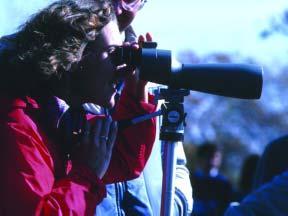
2 minute read
BIRDING Summer, something to get excited about
By Stéphane Guillot
SUMMER IS HERE, the temperature is comfortable and flocks of Canada geese are still filling the skies. The sweet song of a robin awakens you. You can smell it in the air, it’s here—bird watching season. The way I look at it, the groundhog has never been the first sign of spring. How can I tell when spring has arrived?
Advertisement
The answer is in the birds. Whether it is the first sighting of a yellow-rumped warbler or the half a dozen dark-eyed juncos pecking away at my feeder, it is enough to get this birder excited! What do I need to get started?
A long time ago, bird watchers had to rely on their eyesight alone to see birds. Technology has brought us a long way. Birders today can easily identify bird species using binoculars or spotting scopes. Find a decent set of binoculars, a general guidebook about birds, and allow yourself to be captivated by the wonderful world of birding. Be prepared to see species you’ve never seen before. Go to a quiet place where you and nature can be at one, and be observant of the wildlife present. Once you have the tools, it soon becomes easier to identify your birds. As you familiarize yourself with your guidebook, you will develop your own method to distinguish one bird from another. Waiting for something to happen?
It’s a beautiful sunny morning; you pick up your binoculars and your Petersen guide and head out to your favourite nature spot, hoping to experience the sighting of your life. You arrive there and all the birds fly away. Take a moment to appreciate the view, and listen for anything that may have stayed behind. Eventually, you will begin to hear sounds, busier and louder sounds, and suddenly you will be surrounded with birds you never knew were there.
Often enough, sitting down and being quiet will allow things to get back to normal. Patience is the key to birding. On most occasions it will be a while before you notice any activity. What should I be looking for?
Areas with a good variety of wildlife are likely to have birds present. Look for thick brush and running water. Many species of birds will nest in areas with these characteristics. Marshy landscapes are quite productive to a birder, as ducks and herons need wetlands to feed and survive. Small bushes or shrubs offer refuge to smaller birds such as warblers and goldfinches, among many others. Where do I get started?
There are many places to go bird watching around Ottawa. Mud Lake can offer as many as 200 species during the year, Mer Bleue Bog has a wonderful variety of birds and mammals, and Shirley’s Bay is also a great area to bird watch. These are just some examples of areas plentiful in bird life. The fun in bird watching
There is great satisfaction in helping people see different species of birds. Birders are rewarded by the look on people’s faces when they hear the cheerful call of a Flicker, or by the smiles that form while people watch Chickadees feed out of their hands.
With any luck, this will help to get you started. Good Birding!









